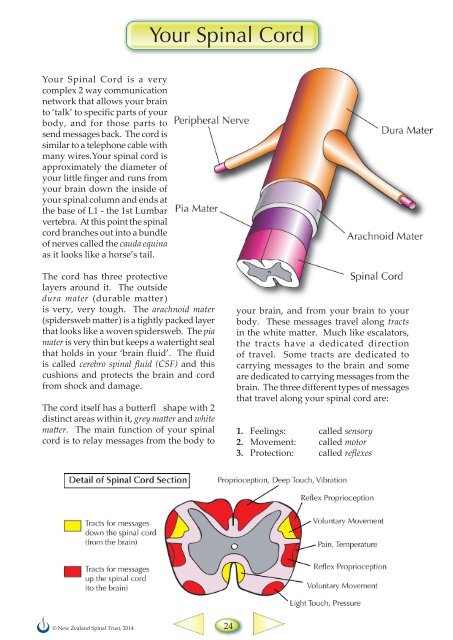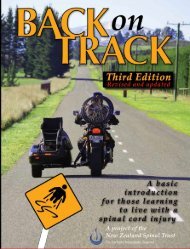o_19m515s4j1asl13rsiok91e166nh.pdf
You also want an ePaper? Increase the reach of your titles
YUMPU automatically turns print PDFs into web optimized ePapers that Google loves.
Your Spinal Cord<br />
Your Spinal Cord is a very<br />
complex 2 way communication<br />
network that allows your brain<br />
to ‘talk’ to specific parts of your<br />
body, and for those parts to<br />
send messages back. The cord is<br />
similar to a telephone cable with<br />
many wires.Your spinal cord is<br />
approximately the diameter of<br />
your little finger and runs from<br />
your brain down the inside of<br />
your spinal column and ends at<br />
the base of L1 - the 1st Lumbar<br />
vertebra. At this point the spinal<br />
cord branches out into a bundle<br />
of nerves called the cauda equina<br />
as it looks like a horse’s tail.<br />
The cord has three protective<br />
layers around it. The outside<br />
dura mater (durable matter)<br />
is very, very tough. The arachnoid mater<br />
(spidersweb matter) is a tightly packed layer<br />
that looks like a woven spidersweb. The pia<br />
mater is very thin but keeps a watertight seal<br />
that holds in your ‘brain fluid’. The fluid<br />
is called cerebro spinal fluid (CSF) and this<br />
cushions and protects the brain and cord<br />
from shock and damage.<br />
The cord itself has a butterfl shape with 2<br />
distinct areas within it, grey matter and white<br />
matter. The main function of your spinal<br />
cord is to relay messages from the body to<br />
your brain, and from your brain to your<br />
body. These messages travel along tracts<br />
in the white matter. Much like escalators,<br />
the tracts have a dedicated direction<br />
of travel. Some tracts are dedicated to<br />
carrying messages to the brain and some<br />
are dedicated to carrying messages from the<br />
brain. The three different types of messages<br />
that travel along your spinal cord are:<br />
1. Feelings: called sensory<br />
2. Movement: called motor<br />
3. Protection: called reflexes<br />
© New Zealand Spinal Trust, 2014<br />
24
















